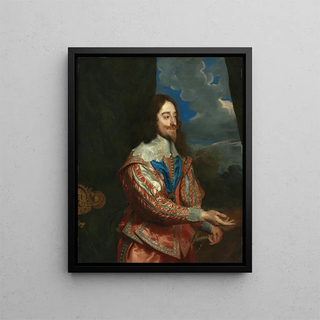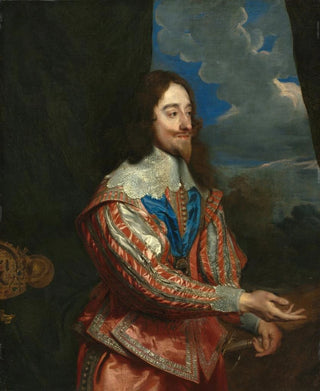Art print | Portrait of Charles I 1600-1649 - Antoine van Dyck


View from behind

Frame (optional)
Reproduction Portrait of Charles I 1600-1649 - Antoine van Dyck – Engaging introduction
The "Portrait of Charles I" by Antoine van Dyck is an iconic work that embodies the elegance and power of the English monarchy in the 17th century. This painting, which captures the complex personality of a king at a crossroads, is much more than a simple portrait. It represents an era when art served as a reflection of political and social issues. The king's ease, his determined gaze, and his majestic posture are all elements that immerse the viewer in the tumultuous world of the English court. The art print of this masterpiece allows for appreciation not only of the artist's technical mastery but also of the psychological depth emanating from this representation.
Style and uniqueness of the work
Antoine van Dyck, as a court portraitist, developed a style that combines realism and idealization. In the "Portrait of Charles I," he uses a palette of rich colors and subtle play of light to emphasize the king's features. The drapery of the robe, carefully crafted, almost seems to come alive under the artist's brush, while the dark background highlights the central figure. The composition is carefully balanced, with each element designed to guide the viewer's gaze toward the king's face. This painting stands out for its ability to convey not only the physical appearance of the sovereign but also his aura and charisma. The king's expression, both serene and resolute, reflects the complexity of his reign, marked by internal conflicts and power struggles.
The artist and his influence
Antoine van Dyck, born in Flanders, had a significant impact on the art world, notably as a portraitist. His encounter with the English court marked a turning point in his career, allowing him to develop a style that would influence many artists across Europe. Van Dyck captured the essence of his subjects with unprecedented precision and sensitivity. His innovative approach to portraiture paved the way for a new way of representing royal figures, combining grandeur and intimacy. Van Dyck's legacy endures, and his influence is still felt today in the work of many

Matte finish

View from behind

Frame (optional)
Reproduction Portrait of Charles I 1600-1649 - Antoine van Dyck – Engaging introduction
The "Portrait of Charles I" by Antoine van Dyck is an iconic work that embodies the elegance and power of the English monarchy in the 17th century. This painting, which captures the complex personality of a king at a crossroads, is much more than a simple portrait. It represents an era when art served as a reflection of political and social issues. The king's ease, his determined gaze, and his majestic posture are all elements that immerse the viewer in the tumultuous world of the English court. The art print of this masterpiece allows for appreciation not only of the artist's technical mastery but also of the psychological depth emanating from this representation.
Style and uniqueness of the work
Antoine van Dyck, as a court portraitist, developed a style that combines realism and idealization. In the "Portrait of Charles I," he uses a palette of rich colors and subtle play of light to emphasize the king's features. The drapery of the robe, carefully crafted, almost seems to come alive under the artist's brush, while the dark background highlights the central figure. The composition is carefully balanced, with each element designed to guide the viewer's gaze toward the king's face. This painting stands out for its ability to convey not only the physical appearance of the sovereign but also his aura and charisma. The king's expression, both serene and resolute, reflects the complexity of his reign, marked by internal conflicts and power struggles.
The artist and his influence
Antoine van Dyck, born in Flanders, had a significant impact on the art world, notably as a portraitist. His encounter with the English court marked a turning point in his career, allowing him to develop a style that would influence many artists across Europe. Van Dyck captured the essence of his subjects with unprecedented precision and sensitivity. His innovative approach to portraiture paved the way for a new way of representing royal figures, combining grandeur and intimacy. Van Dyck's legacy endures, and his influence is still felt today in the work of many






